
Global Deep Learning Chipset Market Estimated to Reach US$ 4,170.9 Mn by 2022, Driven by Increased Sales of Different Types of Chips Offering Enhanced Application Capability and Flexibility
Absolute Markets Insights offers its latest published report ‘Deep Learning Chipset Market by Type (Field Programmable Gate Arrays (FPGAs), Graphics Processing Units (GPUs), Central Processing Units (CPUs), Application Specific Integrated Circuits (ASICs)); by Architecture (Neuromorphic Architecture-Based Chips, Von Neumann Architecture-Based Chips); by Power Consumption (High (>100 W), Medium (5-100 W), Low (<5 W)); by Compute Capacity (High (> 1TFlops), Low (< 1TFlops)); by Application Domain (Training, Interference); by Vertical (Aerospace, Medical, Military & Defense, Automotive, Industrial, Consumer, Others); by Regional outlook (U.S., Rest of North America, France, UK, Germany, Spain, Italy, Rest of Europe, China, Japan, India, Southeast Asia, Rest of Asia Pacific, GCC Countries, Southern Africa, Rest of MEA, Brazil, Rest of Latin America) – Global Insights, Growth, Size, Comparative Analysis, Trends and Forecast, 2018 - 2026’. The author of the report analyzed that global deep learning chipset market accounted for US$ 723 million in 2017. The adoption of different types of deep learning chipsets that enable applications to consume less power and at the same time become more responsive, flexible and capable, which is likely to expand the aforementioned market.
Purchase the complete report titled “Deep Learning Chipset Market - Global Insights, Growth, Size, Comparative Analysis, Trends and Forecast, 2018-2026” at https://www.absolutemarketsinsights.com/reports/Deep-Learning-Chipset-Market-2018-2026-52

Deep learning is a subset of artificial intelligence and machine learning that uses multi-layered artificial neural networks to deliver state-of-the-art accuracy in tasks such as object detection, speech recognition, language translation and others. Deep learning is responsible for many of the recent breakthroughs in AI such as Google DeepMind’s AlphaGo, self-driving cars, intelligent voice assistants and many more. The accelerated deep learning frameworks/chipsets allow researchers and data scientists can significantly speed up deep learning training, that could otherwise take days and weeks to just hours and days. The chipset’s highly flexible architectures can learn directly from raw data and can increase their predictive accuracy when provided with more data.
However technological limitations such as the lack of abstraction and reasonability capabilities are expected to hinder the growth of the deep learning chipset market.
Graphics Processing Units (GPUs) Anticipated to be the Dominant Segment During the Forecast Period, 2018-2026
Among the types, GPUs is a dominant segment holding the largest market share. For machine Learning tasks, GPUs (with some CPUs in the mix) were found to be between 10 and 100 times as fast as CPU-only machine learning solutions, depending on the exact task. This acceleration was revolutionary and dramatically expanded the deep learning chipset market for machine learning hardware and solutions. CPUs were still used, but the virtues of GPUs increased the size of the pie, with machine learning being used much more widely than it had been before 2009.
On the Basis of Geography, North America holds the Largest Share Globally
In 2017, North America was the largest market in terms of revenue globally. The high demand for deep learning chipsets in the North American market is attributed to the rising number of startups in the region. Also, high funding for R&D activities with regards to machine learning and integrating artificial intelligence technology has propelled the growth of the market in this region.
Deep Learning Chipset Market is Fragmented with the Presence of Global and Regional Players
Some of the key participants in Deep Learning Chipset Market are Amazon Web Services, Inc., ARM Limited, CEVA Inc., Facebook, Google LLC., Graphcore, IBM Corporation, Intel Corporation, Nvidia Corporation, Qualcomm Technologies, Inc., Teradeep Inc., and Xilinx Inc. amongst others. In 2018, Apple unveiled the A11 Bionic chip, which powers the iPhone 8, 8 Plus and X. The A11 Bionic features a neural engine that is purpose-built for machine-learning among other things. This new architecture enables machine-learning computations, which used to be processed in the cloud, can now be carried out more efficiently on a device.
- Deep Learning Chipset Market – By Type
- Field Programmable Gate Arrays (FPGAs)
- Graphic Processing Units (GPUs)
- Central Processing Units (CPUs)
- Application Specific Integrated Circuits (ASICs)
- Market By Architecture
- Von Neumann Architecture-Based Chips
- Neuromorphic Architecture-Based Chips
- Market By Power Consumption
- High (>100 W)
- Medium (5-100 W)
- Low (<5 W)
- Market By Compute Capacity
- High (> 1TFlops)
- Low (< 1TFlops)
- Market By Application Domain
- Training
- Interference
- Market By Vertical
- Consumer
- Industrial
- Automotive
- Military & Defense
- Medical
- Aerospace
- Others
- Market By Region
- North America
- U.S.
- Rest of North America
- Europe
- France
- The UK
- Spain
- Germany
- Italy
- Rest of Europe
- Asia Pacific
- China
- Japan
- India
- Southeast Asia
- Rest of Asia Pacific
- Middle East and Africa
- GCC Countries
- Southern Africa
- Rest of Middle East and Africa
- Latin America
- Brazil
- Rest of Latin America
- North America

